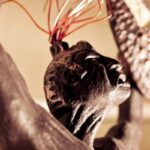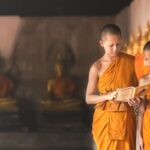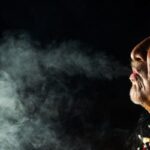We explain what the Umbanda religion is, what its characteristics and origin are. Also, their beliefs, ceremonies and spiritual guides.
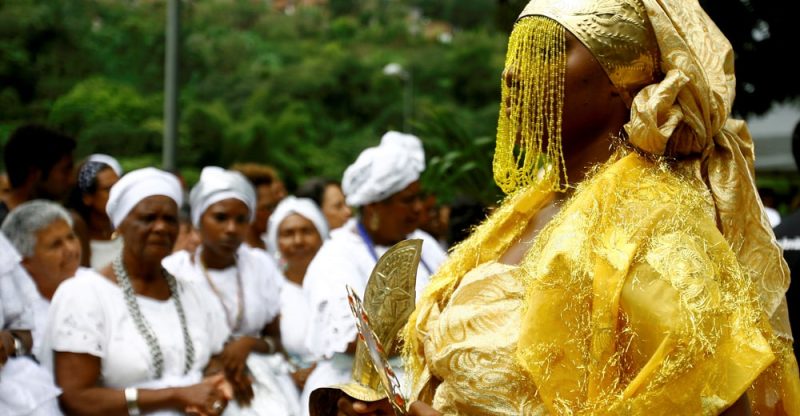
What is umbanda?
The umbanda is a religion of Brazilian origin that includes elements of African, Hindu, Christian and indigenous origin. It is a belief originally from Brazil that has spread to neighboring territories such as Paraguay, Argentina and Uruguay. It emerged at the beginning of the 20th century linked to spiritualism rituals.
Practitioners of umbanda believe in the existence of a single supreme god called Olorun, Obatalá or Zambi which is considered the source of all life and spiritual energy. In addition, they maintain that there are other spiritual entities called “orixás”, which are manifestations of specific aspects of nature and human life, such as love, war and healing, among others.
The Umbanda religion is organized around autonomous communities of faithful and does not have a hierarchical institutional unit. Furthermore, there are different variants that differ with respect to doctrinal or practical aspects, or spiritual approaches.
“Umbanda” is a term from Kikongo (a Bantu language native to Angola) that translates as “the art of healing.” This idea is linked to the practices of African healers to heal people in their community.
Frequently asked questions
What is umbanda?
Umbanda is an Afro-Brazilian religion that combines elements of spiritualism, Catholicism, and African and American traditions.
What does “orixá” mean for the Umbanda religion?
The orixás are spiritual entities venerated in the Umbanda religion that represent aspects of nature and human life.
What is the main objective of the umbanda rituals?
Rituals seek spiritual healing, guidance and help through the incorporation of spirits and the practice of charity.
What are the “terreiros” of the umbanda?
The terreiros are temples where religious ceremonies are held and the spiritual teachings of the umbanda are practiced.
- See also: Candomblé
Characteristics of the umbanda
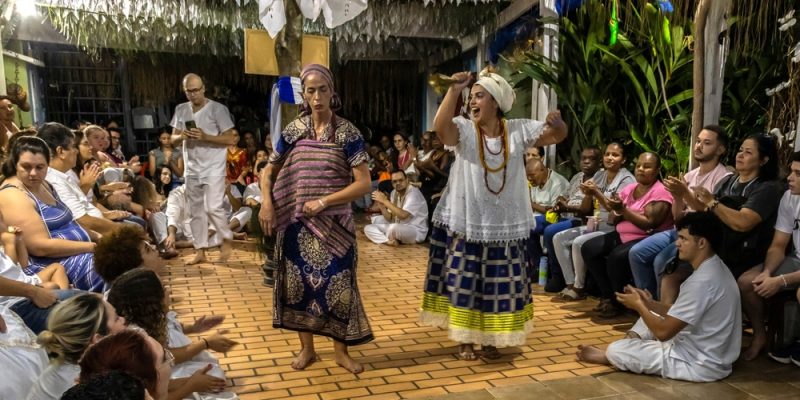
Among the main characteristics of the umbanda are:
- religious syncretism. Umbanda combines elements of African religions, Catholicism, Kardecist spiritualism and indigenous Brazilian traditions, reflecting the cultural diversity of Brazil.
- Cult of orixás and spiritual entities. Practitioners worship orixás (African deities) and various spiritual entities, such as caboclos, pretos-velhos and criançaseach with specific roles and characteristics.
- Mediumship. During the rituals of the Umbanda religion, mediums communicate with spirits, entering a trance to transmit messages and perform healings.
- Rituals and ceremonies. The rituals of the umbanda include songs, dances and offerings to the orixás and spirits, accompanied by music and drums.
- Values. The Umbanda religion promotes charity, respect, humility and tolerance, emphasizing service to others and sincerity in spiritual practice.
- Healing practices. Herbs, ritual baths and amulets are used to heal and protect worshipers from negative energies and spiritual illnesses.
- It may help you: Worship
Origin of the umbanda
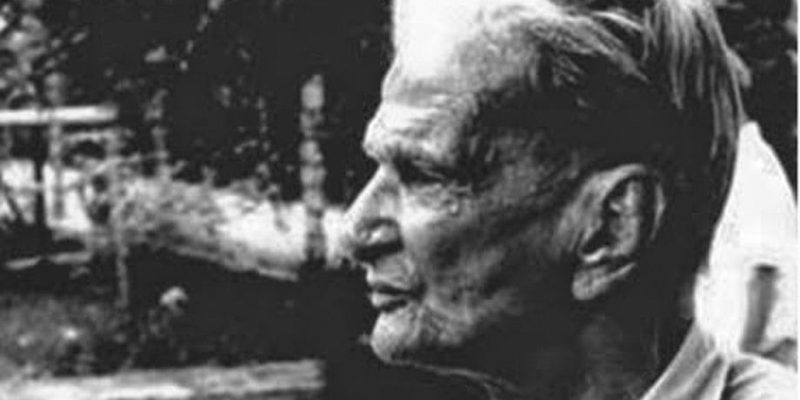
It is considered that The origin of the Umbanda religion dates back to 1908. According to tradition, the young Zélio Fernandino de Moraes began manifesting spirits in an unusual way during a spiritualist session. One of the spirits that manifested identified itself as the Caboclo das Sete Encruzilhadas (which in Portuguese means “the spirit of the seven crossroads”) and declared that he was there to found a new religion.
This new church would be an amalgamation of African, Catholic, spiritualist and indigenous beliefs. That night, the caboclo spirit, alternating with another entity called Preto Velho Pai Antonio (“old black dad Antonio”), instructed those present in the creation of the Spiritist Tenda Nossa Senhora da Piedade (“spiritual tent of our lady of piety”) and the practice of numerous rites, thus laying the foundations of the Umbanda religion.
- See also: Animism
Umbanda beliefs
The Umbanda religion It is monotheistic and maintains that there is a single all-powerful deity which is inaccessible to human beings. This deity is called Olorun, Obatalá or Zambi.
As for Catholicism, this supreme god is the creator of everything that exists. In each ritual ceremony, he is prayed to at the beginning and at the end, and he is named with the phrase: “Above Him, no one.”
However, The umbandistas maintain that he is an inaccessible god and that its energy manifests in the world through various spiritual guides, known as orixás. Together, these spirits make up a pantheon that people can access through the offices of a medium and the ritual practices of spiritualism.
- It may help you: Monotheism
The seven lines of the umbanda
The Umbanda religion maintains that there are universal human values, known as “the seven lines of the Umbanda.” These precepts give meaning to existence and serve to guide people's behavior towards harmony with their environment.
These seven lines are also linked to certain materials and specific elements of reality, as follows:
| Line | Worth | Element | Power area | Symbols and attributes |
|---|---|---|---|---|
| Oxalá | Faith | Glass | Purity, peace, spirituality, divine connection. | White and gold colors, symbols of purity and peace. |
| ogum | Love | Mineral (metal) | Strength, justice, protection, technology. | Metal tools, keys of paradise, dark blue and green colors. |
| Oxossi | Knowledge | Vegetable (plants) | Hunting, nature, wisdom, sustenance. | Bow and arrow, green and yellow colors, elements of nature. |
| Xango | Balance | Igneous (fire) | Justice, balance, transformation. | Double-edged axe, red and brown colors, symbols of justice and fire. |
| Iansã (Oyá) | Order | Wind (air) | Dynamism, chaos control, protection. | Wind, red and brown colors, symbols of movement and change. |
| Obaluaiê | Transmutation | Telluric (earth) | Health, illness, renewal, transformation. | Cloth on the head, ivy, cundeamor, coralillo, brown and dark red colors. |
| Iemanjá | Life | Aquatic (water) | Motherhood, protection, abundance. | Water, fish, blue and white colors, symbols of motherhood and life. |
Through spiritual work, the guidance of the spirits and the connection with the appropriate material elements, the faithful of the umbanda seek to lead their lives towards a greater good and the fulfillment of a sacred mission in the world.
- See also: Ethical values
Umbanda practices and ceremonies
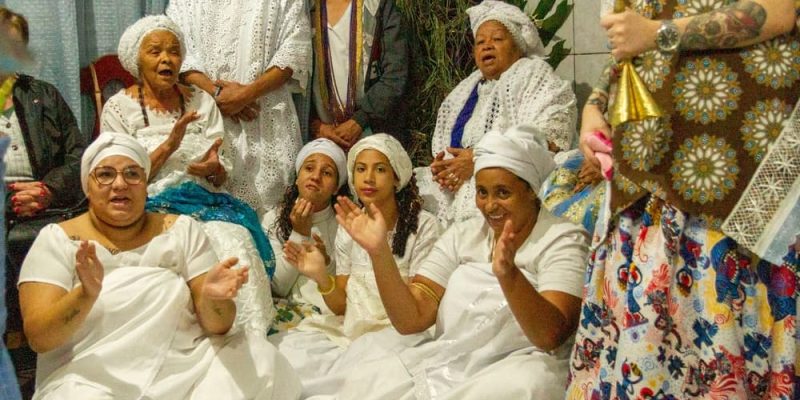
Umbanda practices are very varied. In general, These are rituals that seek to link human beings with their own spiritual guides.
Ritual procedures and their forms are determined by the priest (Pai-de-santo, babaloxa either babalah) that interprets the wishes of the spirit guide. These rites are usually carried out in tends or spiritual houses, previously suitable for invoking spirits.
Among the most important Umbanda practices are:
- Possessions. They consist of the invocation of one or more spirits to penetrate the body of the medium, under the ritual tutelage of the priest. These spirits are usually eguns (mythical ancestors), caboclos (indigenous spirits) or pretos-velhos (African spirits), and even some orishas. During the time of possession, the mediums enter a trance and can communicate the divine will to those present.
- initiation rites. They involve the use of symbols and sometimes the sacrifice of animals. The initiates' heads are washed, their hair is cut and they are bathed in the blood of the animal, in order to mark their death as profanes and their rebirth as followers of the umbanda.
- Offerings. The link between human beings and divinities is made through the symbolic exchange of goods, animal sacrifices and food, depending on what the orixá “requests.” These rites are combined with communion practices, processions, prayers and songs of the Christian liturgy, with offerings of tobacco, liquor, candles, flowers, rice, perfumes and meat from roosters and chickens, to name a few examples.
Furthermore, the Umbanda has a very diverse ritual calendar, in which Catholic festivities are combined with those of African origin. For example, September 8 is the day of Oxum (Ochún or Oshun), orixá equivalent to the Virgin of Charity of Copper.
Orixás or spiritual guides
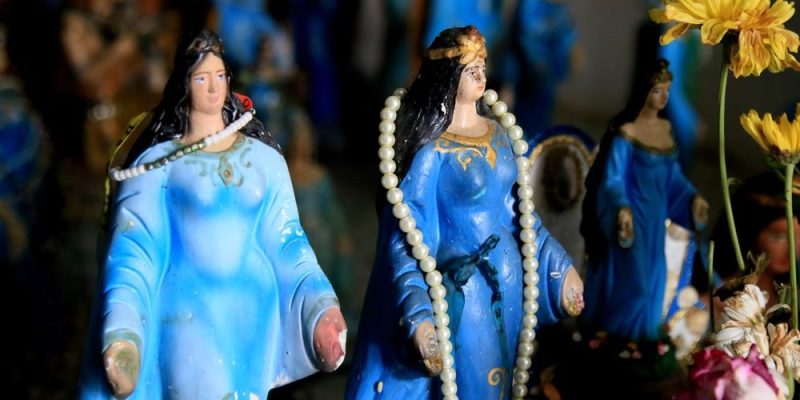
The pantheon of the Umbanda orixás is mainly composed of the following spiritual entities:
Oxalá
Oxalá is the most important of the orixás and the first one created by Olorun. It has feminine and masculine features at the same time. It is syncretized with the Christ of the last days and sometimes with the Virgin of Mercedes.
He is the creator of the Earth and the human being owner of everything white, of thoughts, head and dreams. In other religions of African origin, it is known as Ochalá or Obbatalá.
Xango
Xangó is the orixá of justice, lightning, thunder and fire. It is syncretized in Santeria with San Marcos and Santa Bárbara. It has a double historical and divine feature, since it is assumed that he was the fourth mythical king of the Nigerian city of Oyo.
He is a violent and vengeful orixá, owner of the sun and storms; strong, brave and fair. He is credited with several wives and the use of a double-edged axe. In other religions of African origin, it is known as Changó or Shangó.
ogum
Ogum is a warrior orixá. He is the patron of blacksmithing, metals and technology, and the protector of surgeons, soldiers and police officers.
Of irascible and violent character, He is represented with the machete with which he tears apart his rivals or makes his way through the jungle vegetation. He is associated with Saint George of the Christian pantheon, and often with Saint Peter, since he holds the metal keys to paradise. In other religions of African origin, it is known as Oggun or Ogún.
Oxossi
Oxossi is a hunting orixá. It is the patron of prisoners and fugitives and owner of the bow and arrow. He is considered a wizard or witch, and is associated with the colors blue, yellow and coral. Intelligence, sagacity and inventiveness are his.
He is the best of hunters whose arrows never fail, and who provides sustenance to the prisoners. Brother of Xangó and Ogum, he is the son of Oxalá and Iemanjá. In other religions of African origin, it is known as Oshosi or Ochosi.
Iemanjá
Iemanjá is a female orixá associated with the sea, abundance and motherhood. In addition, it is the most popular orixá, publicly revered in Brazil and in various regions of the Caribbean and the United States.
She is the protector of sailors and fishermen, and mother of all fish. She is the bearer of numerous epithets such as “lady of the waters”, “mother of water” and “mother of all orixás”. Drowned people are claimed by her to live as her husbands and wives, which is why she has come to be associated with European mermaids; In different senses, it is more associated with the Virgin Mary. In other religions of African origin, it is known as Yemayá or Jemanjá.
Oxum
Oxum is a female orixá associated with fertility. She is the owner of bronze and all the rivers. Theirs are also the Sabbath and the color gold.
She is represented as a vain, sensual woman who goes to the river to bathe dressed in necklaces and ornaments. She is associated with the Virgin of the Most Holy Charity of Cobre, and was one of Xangó's wives. In other religions of African origin, it is known as Ochún or Oshun.
Oba
Obá is a female orixá associated with sacrificial love and marital fidelity. It is the owner of the lakes and lagoons, and lives in the cemeteries, where it guards the tombs.
She is represented as a strong, fearsome, envious and misunderstood woman. She does not usually have sons among the faithful, and is associated with the color old pink, the dagger, and soup and tureens. Her cult is syncretic with that of Saint Catherine or Saint Rita of Casia. In other religions of African origin, it is known as Obba or Obbá.
Oxumare
Oxumare is an androgynous orixá. It is associated with the snake and the colors red and blue which represent the masculine and the feminine, respectively. Theirs are movement, wealth and balance.
It is responsible for sustaining the water cycle and that which remains, that endures. He is the guarantor that things continue as they go. In other religions of African origin, it is known as Oshunmare or Oshumare.
Obaluaie
Obaluaié is a male orixá. It is the lord of the earth, disease, venereal infections and, in general, of plague and misery. He is a nocturnal deity, who during the day hides in the ivy, the cundeamor or the coralillo. He is the orixá responsible for the selection of the deceased.
He is represented with a cloth over his head since his face is covered with wounds, and he usually asks for sacrifices of goats, chickens or doves. In other religions of African origin, he is known as Babalú Ayé or Obaluayé.
Criticisms of the umbanda
The practice of umbanda, like many religions and spiritual systems, It has been the subject of various controversies and criticisms over time. These controversies may vary depending on the cultural, social and religious context. Like followers of other Afro-Brazilian religions, umbandistas have faced persecution and discrimination, both from society in general and from religious and political institutions.
Some people criticize the umbanda rituals because they include animal sacrifices. In response, the faithful argue that the sacrifices are symbolic and ritualized, and that they are part of an ancient tradition that has deep spiritual meaning.
Besides, the morality and ethics of some practices have been questioned within the Umbanda religion, such as the commercialization (payment) of rituals, consultations with spirits and magical practices. Umbandistas maintain that, although some abuse the faith, there are many leaders who condemn these practices and strive to maintain the integrity and purity of their traditions.
References
- Engler, S. (2017). Umbanda. In B. Schmidt and S. Engler (Eds.), Handbook of Contemporary Religions in Brazil. Brill.
- Giobellina Brumana, F and González Martínez, E. (2000). Umbanda. The power of the margin. University of Cadiz.
- Klein, F. (2006). Quimbanda and umbanda. Afro-Brazilian cults in the Río de la Plata. Anthropology Gazette(22), article 29.

